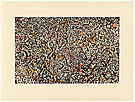Mark TOBEY
Mark Tobey was born in Wisconsin on 11 December 1890. One of the early pioneers of Abstract Expressionism, he had little formal training aside from a few classes at the Art Institute of Chicago. From 1911 Tobey worked as a fashion illustrator, interior decorator and portrait draughtsman in New York. He had his first solo exhibition there, at the Knoedler Gallery, in 1917.
Tobey’s influences were eclectic: his conversion to the Baha'i faith in 1918 had a profound impact on both the themes and style of his art. In the early 1920s he developed an interest in European Cubism and East Asian painting and calligraphy. He travelled extensively in both Europe and Asia; in 1934 he studied Oriental philosophy and art in China, and lived in a Zen monastery in Japan. These experiences played a crucial role in the development of his signature 'white writing' style—interlacing networks of fine white lines on a dark ground, overlayed with calligraphic symbols—which would later invite comparisons between his work and that of Jackson Pollock. In 1939 Tobey began studying piano, music theory and music composition, disciplines that also greatly influenced his work.
In 1958 Tobey became the second American to win the International Grand Prize at the Venice biennale. In 1960, he moved to Basel, Switzerland. His work was shown in the Kassel Documentain 1959 and 1964. Several retrospectives have been held: at the Seattle Art Museum in 1959 and in 1970–71; at the Whitechapel Gallery, London, in 1962; and at the Smithsonian Institution, Washington, in 1974. Tobey died in Basel on 24 April 1976.


